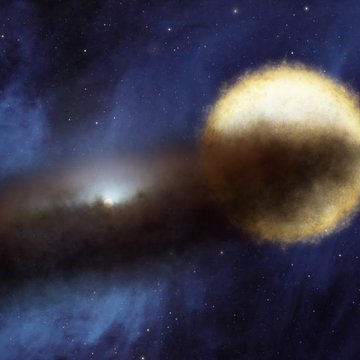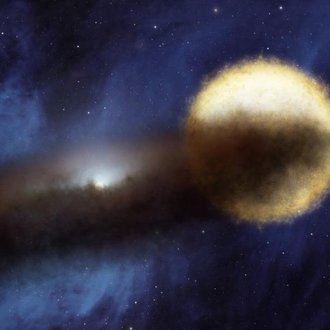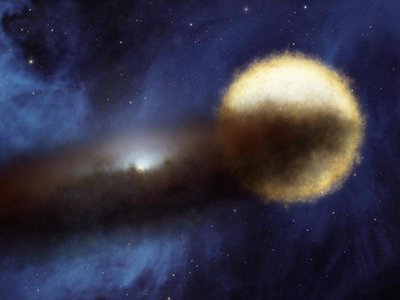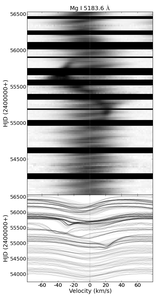Epsilon Aurigae - an extremely dynamic binary star
Based on an observation campaign lasting seven years, scientists from the Leibniz Institute for Astrophysics Potsdam (AIP) published new findings about the binary star system Epsilon Aurigae in Astronomische Nachrichten (Astronomical Notes). The observation data was obtained using AIP’s robotic STELLA telescope on Tenerife.
Epsilon Aurigae is a bright supergiant with a diameter 300 times greater than that of the Sun; its mass is 25 times greater. Its mysterious companion star is concealed in a disk, and cannot be observed directly. Thanks to their observations, Potsdam’s astronomers were able to show that the main star pulsates non-radially, rotates very quickly and loses mass to its invisible companion, whose accretion disk also rotates.
The binary star system must be extremely dynamic for the mass to be able to flow, as proven, from the supergiant towards the disk of the invisible companion star. The astronomers determined that the giant star rotates comparatively quickly, with a period of only 540 days. In interaction with its non-radial pulsation, which has also been observed, this could be the cause of intensified mass transfer between the two stars.
“I would not like to get too close to Epsilon Aurigae with my spacecraft,” stated Professor Klaus Strassmeier, leader of the study and Research Branch Director at AIP. “What we see here is a system whose two very massive stars are simultaneously involved in all of the turbulent scenarios of stellar evolution.”
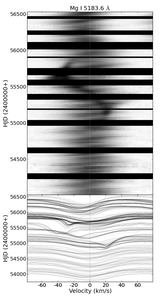
The figure shows a dynamical spectrum of the line-profile of the Mg I 518.4nm line of epsilon Aurigae during the most recent eclipse 2009-2011. Shown is an excert ±8nm around the line core. Starting at eclipse ingress a sharp-lined absorption component appears and sinusoidally sweeps through the profile. It is the signature of a rotating disk around the unseen secondary star. Time progresses from bottom to top in days.
Credit: AIPDetermining the companion star in further detail remains an exciting task. In fact, the data also shows that the disk of the companion star is not extended in a circular, but in a “pear-shaped” fashion in the opposite direction to the orbital motion. Consequently, it is not possible to determine the mass of the star directly, as is the case for circular disks derived from Kepler’s laws.
Potsdam’s astronomers have been interested for a long time in Epsilon Aurigae, some 3,000 light years away in the northern sky. As early as in 1903, Hans Ludendorff and Hermann Vogel carried out the first photometric and spectroscopic observations of the star at Potsdam, and discovered that it was an eclipsing binary star with a 27-year period – the longest eclipsing period that has ever been measured.
The huge quantities of data obtained using the STELLA telescope are made available to the astronomical community for further analysis.
The study "Time-series high-resolution spectroscopy and photometry of ε Aurigae from 2006–2013: Another brick in the wall" was published in November in Astronomical Notes, Vol. 335, issue 9.
The Artist's impression shown above is available on the NASA website.
Science contact: Professor Dr. Klaus G. Strassmeier, kstrassmeier@aip.de
Media contact: Kerstin Mork, presse@aip.de, 0331-7499 469
Based on an observation campaign lasting seven years, scientists from the Leibniz Institute for Astrophysics Potsdam (AIP) published new findings about the binary star system Epsilon Aurigae in Astronomische Nachrichten (Astronomical Notes). The observation data was obtained using AIP’s robotic STELLA telescope on Tenerife.
Epsilon Aurigae is a bright supergiant with a diameter 300 times greater than that of the Sun; its mass is 25 times greater. Its mysterious companion star is concealed in a disk, and cannot be observed directly. Thanks to their observations, Potsdam’s astronomers were able to show that the main star pulsates non-radially, rotates very quickly and loses mass to its invisible companion, whose accretion disk also rotates.
The binary star system must be extremely dynamic for the mass to be able to flow, as proven, from the supergiant towards the disk of the invisible companion star. The astronomers determined that the giant star rotates comparatively quickly, with a period of only 540 days. In interaction with its non-radial pulsation, which has also been observed, this could be the cause of intensified mass transfer between the two stars.
“I would not like to get too close to Epsilon Aurigae with my spacecraft,” stated Professor Klaus Strassmeier, leader of the study and Research Branch Director at AIP. “What we see here is a system whose two very massive stars are simultaneously involved in all of the turbulent scenarios of stellar evolution.”

The figure shows a dynamical spectrum of the line-profile of the Mg I 518.4nm line of epsilon Aurigae during the most recent eclipse 2009-2011. Shown is an excert ±8nm around the line core. Starting at eclipse ingress a sharp-lined absorption component appears and sinusoidally sweeps through the profile. It is the signature of a rotating disk around the unseen secondary star. Time progresses from bottom to top in days.
Credit: AIPDetermining the companion star in further detail remains an exciting task. In fact, the data also shows that the disk of the companion star is not extended in a circular, but in a “pear-shaped” fashion in the opposite direction to the orbital motion. Consequently, it is not possible to determine the mass of the star directly, as is the case for circular disks derived from Kepler’s laws.
Potsdam’s astronomers have been interested for a long time in Epsilon Aurigae, some 3,000 light years away in the northern sky. As early as in 1903, Hans Ludendorff and Hermann Vogel carried out the first photometric and spectroscopic observations of the star at Potsdam, and discovered that it was an eclipsing binary star with a 27-year period – the longest eclipsing period that has ever been measured.
The huge quantities of data obtained using the STELLA telescope are made available to the astronomical community for further analysis.
The study "Time-series high-resolution spectroscopy and photometry of ε Aurigae from 2006–2013: Another brick in the wall" was published in November in Astronomical Notes, Vol. 335, issue 9.
The Artist's impression shown above is available on the NASA website.
Science contact: Professor Dr. Klaus G. Strassmeier, kstrassmeier@aip.de
Media contact: Kerstin Mork, presse@aip.de, 0331-7499 469
Images
Artist's impression of Epsilon Aurigae.
The figure shows a dynamical spectrum of the line-profile of the Mg I 518.4nm line of epsilon Aurigae during the most recent eclipse 2009-2011. Shown is an excert ±8nm around the line core. Starting at eclipse ingress a sharp-lined absorption component appears and sinusoidally sweeps through the profile. It is the signature of a rotating disk around the unseen secondary star. Time progresses from bottom to top in days.
